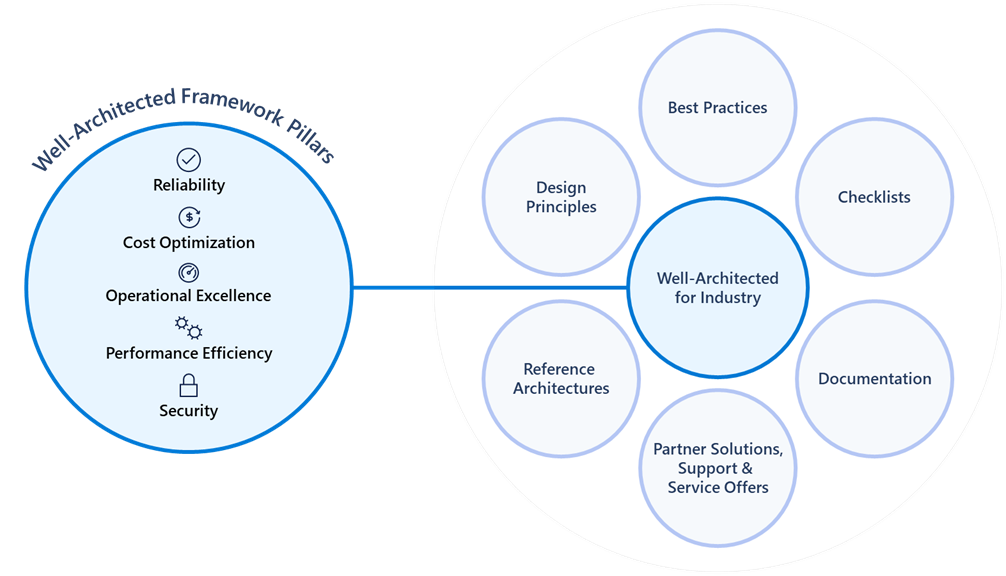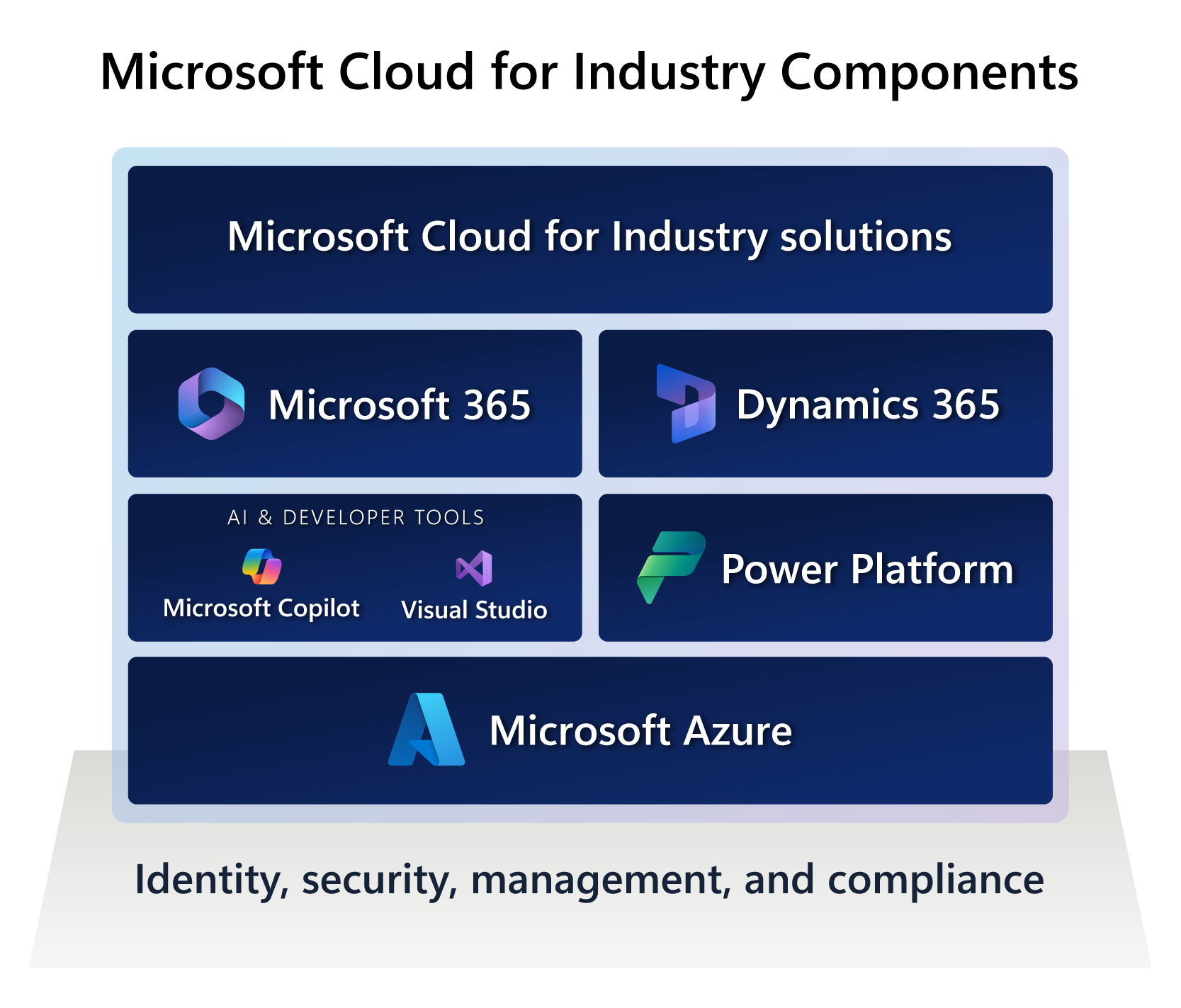Overview of Well-Architected for Industry
Well-Architected for Industry is a set of guiding principles that you can use to improve the quality of your industry cloud workloads. It applies the existing Microsoft Azure Well-Architected Framework principles to Microsoft Cloud for industry solutions, which consist of the following five pillars of architecture excellence:
Using these principles helps you create better, more reliable, and more efficient industry cloud architecture.
The following diagram gives a high-level overview of Well-Architected for Industry assets that support these pillars:
Well-Architected for Industry contains six supporting elements:
- Reference architecture: Reference architecture for Microsoft Cloud for industry solutions, tailored to each solution play.
- Design principles: Design principles and key concepts to guide solution building with Microsoft Cloud for industry solutions.
- Best practices: Design, deployment, and operational best practices
- Checklists: Checklists or self-assessment tool to assess industry cloud workload design, deployment, and operation.
- Documentation: Technical documentation references and technical assets to re-use in implementation.
- Partner solutions, support, and services offers: Documentation on integrated third-party solutions, technical guidance, and related support and service offers.
Audience
The Well-Architected for Industry applies to teams that are responsible for improving industry cloud workloads and addressing cross-cutting concerns. Regardless of your role in a workload team, whether architect, developer, operator, or business stakeholder, if you have the authority to make decisions within the scope of a workload, you can benefit from this guidance.
This guidance is beneficial regardless of the scale of your organization. Whether you're part of a large enterprise, a small business, or an independent software vendor, you can move a step closer to optimal design. The framework caters to a wide range of organizational structures and sizes, ensuring that all workload users can effectively use its benefits.
Assessment
You can use Well-Architected for Industry self-assessment tools for free. It's a collection of categorized questionnaires mapped to either the core pillars or your project implementation phase to evaluate your design, deployment, or operational choices. You can track your score through iterative runs to identify possible areas for enhancement.
| Self-Assessment Tool | Description |
|---|---|
| Microsoft Sustainability Manager Assessment | Assess your Microsoft Sustainability Manager application at different stages of the implementation process, examining various categories to guide a well-structured deployment. |
| Microsoft Cloud for Financial Services Assessment | Assess your Microsoft Cloud for Financial Services workloads through the lenses of configuration and extension scenarios and across the Well-Architected pillars such as reliability, cost management, operational excellence, security and performance efficiency. |
Microsoft Cloud industry building blocks
At the heart of Microsoft Cloud industry solutions are four key building blocks. These blocks enable organizations to build, deploy, and manage intelligent applications and services that drive innovation, improve efficiency, and enhance customer experiences.
Microsoft Cloud solutions are built on a layered architecture that provides a solid foundation for businesses to use the full potential of digital transformation.
The foundational layer of the architecture encompasses essential elements like identity, security, management, and compliance, which are core functionalities inherited from the Microsoft Cloud. These capabilities assist organizations in securing their operations, adhering to regulations, and preserving the integrity of their data. The second tier consists of Azure, which provides infrastructure as a service (IaaS) or platform as a service (PaaS) options, offering businesses scalability, reliability, and flexibility. Above that, you'll find Developer and AI tools such as Visual Studio, Copilot, and Power Platform, offering low-code or no-code applications that empower businesses to create custom apps and workflows without extensive coding expertise. One level further up, you have Dynamics 365, a suite of customer relationship management (CRM) and enterprise resource planning (ERP) applications, and Microsoft 365, a comprehensive productivity suite tailored for frontline workers. Finally, at the topmost layer, there are Microsoft Cloud industry solutions, which are constructed using industry-specific components built on the underlying technologies.
Division of responsibility
Industry cloud solutions encompass Azure, Power Platform, Microsoft 365, and Dynamics 365 building blocks. These building blocks contain IaaS, PaaS, and software as a service (SaaS) components. These components can also have integration points with on-premises components. Each of the five pillars of Well-Architected for Industry (operational excellence, security, reliability, performance efficiency, and cost optimization) will scope for the customers or shared responsibility areas when assessing industry cloud workloads.
The following table describes the division of responsibility between Microsoft and customers based on the type of service.
| Type of service | Microsoft responsibility | Customer responsibility | Some components used in Microsoft Cloud industry solutions |
|---|---|---|---|
| On-premises | N/A | Responsible for the whole stack. | On-premises data gateway |
| IaaS | Secure the underlying infrastructure, such as physical servers, network devices, and data centers. | Secure their applications and data, including data encryption, access control, and compliance with industry regulations. | Azure Virtual Network (VNet), Azure Virtual Machines (VMs) |
| PaaS | Secure the platform, such as the runtime environment, middleware, and development tools. | Secure their applications and data, ensure that they are properly configured and secured, and the data is properly encrypted, stored, and backed up. | Power Platform, Azure Health Data Services, Azure Storage Services, Azure Analytics Services, Azure Logic Apps, Azure Kubernetes Service (AKS) |
| SaaS | Secure the entire software application and the data it processes, including access control, data encryption, and security testing. | Ensure that their users are properly trained and educated on how to use the SaaS application securely, and that their actions don't compromise the security of the application or the data it processes. | Dynamics 365, Microsoft 365 |

